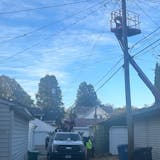A troubled nursing home in Moorhead transported a coronavirus patient to a dialysis center without notifying staff at the center or the driver of the patient's infection, potentially exposing at least nine people to the deadly virus.
At a nursing home in west-central Minnesota, a resident with symptoms of the virus was allowed to attend communal meals and group bingo games, endangering 17 other residents of the facility.
And in Winona, a nursing home with a major coronavirus outbreak moved a patient who appeared sickened with the COVID-19 respiratory illness to a room with someone who was healthy. Staff also wandered about the facility without removing contaminated protective gear.
Those are among the findings of state inspection reports last month of four Minnesota nursing homes with coronavirus cases. The reports, released Wednesday by the state Department of Health, offer a glimpse into how the virus has spread in more than 200 long-term care facilities across the state, killing 759 people and infecting more than 2,600 residents. All told, 81% of the deaths from the virus have been in long-term care — among the highest rates in the nation.
"These violations are the result of long-standing infection-control problems that are becoming glaringly visible in this pandemic," said Kristine Sundberg, executive director of Elder Voice Family Advocates.
All four nursing homes cited were found to have placed their residents in "immediate jeopardy," which means they were put at risk of serious harm or death by the violations. The facilities include the Moorhead Rehabilitation and Healthcare Center, Parkview Home in Belview, Sauer Health Care in Winona, and the Villa at Bryn Mawr in Minneapolis.
The reports illustrate a broader pattern: Nursing homes with a poor track record at controlling infections appear to be particularly vulnerable to the virus' spread. So far, about 75% of Minnesota's nursing homes with outbreaks of COVID-19 have been cited for infection-control violations over the past three years, according to a recent Star Tribune analysis of federal health data. That's higher than the industry average: Nationally, 63% of the nearly 10,000 nursing homes have been cited over the same period, according to Kaiser Health News.
Inspectors found that social distancing guidelines were sometimes poorly enforced and efforts to isolate infected residents often failed. At the Villa at Bryn Mawr, for instance, unsupervised residents shared cigarettes from the same ashtray and sat right next to each other on a patio, putting multiple residents at risk of infection. The nursing home has since removed open ashtrays from its outdoor smoking area, the report said.


